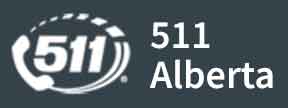Winter Operations FAQ | Mainroad East Kootenay Contracting LP
During winter operations, Mainroad experiences a high frequency of questions from the public – this resource aims to answer most frequently asked questions and provide other helpful resources.
The Ministry of Transportation and Infrastructure published a helpful blog on Service Area 11 Highway Maintenance: Everything you need to know about East Kootenay Highway Winter Maintenance Specifications
Since the award of Ministry of Transportation and Infrastructure’s Service Area 11 Highway Maintenance contract in April, 2016, Mainroad has re-structured its operations to meet the new service requirements and has made a significant investment in new maintenance yards and a new fleet of trucks exceeding $10 million dollars.
- Mainroad invested in the purchase of new and modern snow removal equipment with an increase in material delivery capacity allowing operators to stay longer on the roads to serve the public.
~ 20 tandem axle, 6 tri-axle plows and 6 single axle plows all with wing plows attached supplemented by one additional new tridem wing truck with de-icing spray equipment. - All plow operations are equipped with AVLS (Automated Vehicle Location System) which uses GPS to track the plow locations and ensure efficient deployment of the fleet;
- Maintaining greater stockpiles of materials with additional reserves. Through partnership with Salvador Ready Mix Concrete, Mainroad owns its own supply chain management system so has the capability of producing more winter abrasives when required.
- Mainroad “Snow Desk”: a single point of contact staffed around the clock during severe storm events that has authority to deploy fleet equipment anywhere in the service area as required. This is an internal management function to optimize efficiency during winter operations.
What is the road/highway service area that Mainroad East Kootenay Contracting is responsible for maintaining?
The East Kootenay Service Area is 3,673 lane kilometers including 106 bridges (seven of which are bridge-size culverts), 45 retaining walls, 4,100 culverts, four tunnels (one rock tunnel and three pedestrian underpasses), 11,000 signs and 11 rest areas.
Mainroad East Kootenay Contracting LP is responsible for the maintenance of British Columbia’s provincial highways and roads between Radium Hot Springs (North), Goatfel (West), Alberta (East) and the U.S. border (South).*
Edgewater and Brisco Areas are now part of Service Area 12 | Highway Maintenance Contractor is Emcon Services. 24hr Hotline is 1.866.353.3136
Please Note: Edgewater and Brisco Areas are now part of Service Area 12 | Highway Maintenance Contractor is Emcon Services. 24hr Hotline is 1.866.353.3136
Mainroad is not responsible for plowing within municipal boundaries or on forestry service roads and any snow plow discharge falling on residential driveways is the responsibility of the property owner.
TranBC Link: 4 Reasons Why Piling Your “Private Snow” on Roads is a “No”
- Mainroad’s contract with the Province does not include road/line marking. Pavement marking is a separate maintenance contract with the Province held by LaFrentz Road Marking.
Please contact LaFrentz Road Marking 1-800-859-2947 | lafrentz.ca - Mainroad is not responsible for ice and snow maintenance around mailboxes.
Where are Mainroad's maintenance yards located?
Mainroad is delivering highway maintenance from five yard locations; Cranbrook, Sparwood, Fairmont, Elko and Yahk. Based on our experience, we identified these yard locations as where we can maintain greater stockpiles of materials to serve the local area more efficiently.
How many Mainroad employees are working during winter operations?
Our fleet and crews are fully engaged in winter maintenance operations. Up to 65 employees plus mechanical support are available to work around the clock to keep our roads clear.
How are BC highways classified in the winter?
B.C. highways are classified A, B, C, D & E and are maintained in that order. Winter highway classifications are based on traffic volumes and function. A’s are the first priority; followed by B’s and C’s.
Class “A” highways are high volume routes with over 5,000 winter average daily traffic counts and may include high volume commuter routes through mountain passes.
Class “B” highways are all other routes with winter average daily traffic volumes between 1,000 and 5,000 vehicles.
Class “C” routes are all school bus routes and commercial routes up to 1,000 winter average daily traffic.
Class “D” routes are rural subdivision routes.
Class “E” routes are irregularly maintained routes
Class “F” are not maintained or not open in the winter.
A great example of an “A” in the East Kootenay area is Highway 3 Cranbrook to the BC/AB Border. A main highway or “B” is Highway 93/95 Cranbrook to Canal Flats. “C” routes are other roads that are neither A nor B, but include important roads like school bus routes. “D” and “E” are the roads generally less travelled.
If a route becomes more popular or sees an increase in commercial traffic, the Ministry may upgrade its classification and increase highway operations on that route, as was done to Highway 3, when the route between Cranbrook to Fernie changed to an “A”. It’s all about safety. Changes like this mean an increase in the maintenance commitment, resulting in more frequent patrols and quicker response times, and more plowing, snow removal, and salt and winter abrasive applications, always a good thing when we see winter take hold.
TranBC Link | The ABCs of Winter Highway Classification and Maintenance
How often are BC highways patrolled?
Highway patrol frequencies are based on highway classifications. Patrol vehicles must be equipped to remove snow and provide traction restoration during a weather event or prior to occurring, either forecasted or anticipated slippery or freeze-thaw situations.

Maximum Allowable Accumulation
Basically, this is the maximum amount of snow allowed to accumulate on the highway surface during a weather event. A highway with an “A” classification is allowed up to 4 cm during a weather event, while an “E” is allowed up to 25cm. Class D roads (rural subdivision roads) are required to be plowed within 3 days of the end of the weather event or as required during to stay below the maximum allowable accumulation.

Why are some roads plowed more than others? Which streets get priority?
It’s important for everyone to know that Mainroad’s plowing response time is determined by the standards set by the Ministry of Transportation and Infrastructure. Priority is given to major highway routes such as numbered highways and school bus routes because those are the ones used by emergency services and the majority of traffic. Other road frequency is determined by winter traffic volumes. These frequencies are reviewed annually by the Ministry to ensure that plowing priorities reflect any changes in the road network.
When winter hits, we need to keep service area roads as clear as possible. Sometimes when the snow is falling fast, it can build up quickly again right after the plow passes. In those cases, it’s not uncommon to see those higher-priority routes plowed several times before we can turn our attention to other areas with lower traffic volumes. It can be a real challenge to keep up with clearing the snow during a severe storm event but using the Ministry’s priority approach allows Mainroad to make the best use of resources to keep roads as safe and reliable as possible.
If you’re wondering why it’s taking a while to get a plow along your road this winter, you can always give us a call but please be patient. Our 24 hour hotline is 1-800-665-4929.
TranBC Link | A look behind the scenes at winter maintenance in B.C.
How is highway plowing prioritized?
Highway Snow Removal
- Highways are completed in a priority sequence with snow removal beginning on higher classification main highways.
- Rural side roads are completed once snow removal is completed on main highways or as required to remain within the provincial standard for maximum accumulation.

In accordance with the contract, Mainroad must deploy resources to apply winter abrasives and/or anti-icing chemicals in advance of forecasted or anticipated weather events to prevent the development of slippery conditions. Commencement of snow removal from highways must be in place once there is 3 cm of snow accumulation on the highway surface. Snow removal must be continuous through the weather event and ensure all highways remain below the provincial maximum allowable accumulations in the table above.
Does Mainroad remove snow from sidewalks?
Once snow removal is completed on main highways as per the provincial standard, Mainroad crews will turn their attention to removing snow and ice from pedestrian or wheel chair facilities at intersections, sidewalks, stairways and walkways on Highways, Pedestrian Overpasses and pedestrian tunnels.
What response times does Mainroad adhere to for restoring traction?
Response Times Frames for Restoring Traction
- These must be completed in a priority sequence, with shorter response times on higher class highways.
- Restore traction within the response times below from when Mainroad detects slippery conditions while patrolling or as reported to Mainroad by general public.
- Restoring traction will be completed by either applying winter abrasives on compact sections when pavement temperatures are below -9° or winter chemicals to compact sections to melt snow and ice when pavement temperatures are above -9°C. It is important to recognize de-icing takes several hours and creates slushy conditions during the melt process.

What response times does Mainroad adhere to for snow removal?
The following table shows how long the Ministry allows the remaining snow to sit on the road after a weather event. After the weather event is over, compact snow removal will continue until bare pavement is achieved on Class “A”, “B” and “C” routes (provided pavement temperatures are warmer than -9°C). If pavement temperatures remain colder than -9°C within the outlined time frames – the compact snow can remain until pavement temperatures are -9° and warming.

What response times does Mainroad adhere to for removal of roadkill?
Response times for the removal of roadkill
- Mainroad crews respond to the removal of 1,200 to 1,600 animals in the Service Area annually which is a stat that continues to rise.
- It can be a challenge to safely remove a large animal from the highway but our crews work very hard to meet the response time requirement.

What is Mainroad doing to prepare for a winter storm event?
Our aim is to be proactive during pre-storm activities with emphasis on primary routes which also includes an enhanced pre-treatment program. It is anticipated that we will use four million litres of anti-icing material during winter operations. The proactive use of an anti-icing liquid is a proven way of combatting ice from performing on the highway surface. This technique is used throughout most highway maintenance jurisdictions in North America.
Pre-storm activities include pre-salting and monitoring the forecast closely.
Ahead of a weather event, Mainroad releases regular road and weather updates to a contact list of local agencies, various stakeholders including the Ministry and Media to help inform the public. This helps everyone understand the current conditions, expected weather and Mainroad’s response. These updates are also posted on our social media.
When a weather event occurs, (snow, freezing rain, flooding, etc.) Mainroad crews are working around the clock plowing, sanding and/or salting as conditions warrant and patrolling the service area.
How does Mainroad monitor weather and highways conditions?
As the weather can change rapidly in the East Kootenays during winter, Mainroad is constantly monitoring weather and highway conditions. To determine how best to protect motorists, we oversee weather in two ways:
- Monitoring: Mainroad uses MARWIS, a mobile road weather information sensor that measures road conditions and environmental data both reliably and professionally. The sensor is directly installed on the vehicle to collect weather data such as temperatures, humidity, and dew points. This helps our crews manage the road surfaces.Road Patrols: Prior to, and during a storm event, our operators are on the road observing current conditions and making the calls as to what maintenance is required.
- Forecasting: Mainroad uses data derived from Road Weather Information System (RWIS) stations throughout our maintenance areas for weather forecasting. Seven (7) East Kootenay Service Area roadside stations measure site-specific highway data such as pavement surface temperature and condition, precipitation, snow depth, air temperature, humidity, and wind.Road Weather Forecasting: Environment Canada’s Meteorological Service of Canada does not do road weather forecasting. This vital service is only available through private sector service providers. The Ministry of Transportation and Infrastructure contracts with a leading road weather forecaster, which watches over B.C. weather 24 hours a day, seven days a week.
Environment Canada also contributes to our weather watch, providing regional forecasts. Combined with additional weather information from other sources, these tools help us predict road conditions. But firsthand experience is also a big part of knowing our roads. That is why Mainroad patrols the highways on a regular basis.
What is Mainroad doing to respond to changing conditions during a storm event?
Weather can change rapidly in the East Kootenays during winter which is why Mainroad is constantly monitoring weather and highway conditions.
During a storm event, Mainroad crews will be working to clear the highway surfaces as quickly as possible. When temperatures permit, we will commence anti-icing operations with the goal of getting the compact snow off service area highways and roads. On primary routes, we will aim to have bare and black conditions from the completion of the weather event as quickly as possible, however challenging weather will not always permit us to have bare and black conditions on secondary routes.
Mainroad crews will also be patrolling Service Area highways for down trees and vegetation on the road, however it will take some time to clear a down power line so check DriveBC for updates. Mainroad will coordinate with BC Hydro to determine when the area is safe.
Never try to approach or drive across a down power line. Remain at least three meters (10 feet) away from power lines. That means above, below and beside. Call 911 immediately to report a fallen power line. Avoid touching anything, such as a car, object or equipment, or anyone who is in contact with a fallen power line. Keep children and pets away from fallen electrical lines.
During every storm event, Mainroad will provide the Ministry and Media with regular updates.
Driveway Culvert Maintenance Responsibilities on BC Highways: Your Questions Answered
- Feel free to contact Mainroad’s 24-hour hotline to report a driveway culvert or culvert maintenance issue.
- Alternatively you can contact your local Ministry Regional and District Office Staff. Information available at this link: Transportation Reports and Reference – Regional District Contacts

What materials does Mainroad use for winter road maintenance and when are these materials applied?
Mainroad uses three materials for winter road maintenance: winter abrasive, anti-ice liquids and salt. The use of a specific material is determined by the forecast and actual weather conditions and in accordance with the standard set by the Ministry.
Anti-icing Liquids (brine): Anti-icing liquids are used as a preventative material prior to snowfall. Typically, these materials are applied prior to a forecasted winter event and dry on the highway surface to provide early on snow melting capabilities. Brine can also act as a de-icing agent during a storm or once a storm has passed and can help to remove packed snow and ice from the road surface. After snow has been cleared, liquid anti-icing brine is an important component in Mainroad’s plan to prevent ice from forming as it breaks down the bonding ability of ice on the road surface.
Learn more about Mainroad’s liquid anti-icing program

Salt: Salt is a staple of our winter maintenance routine. Sometimes salt is used in a liquid, sometimes in a solid. It helps to melt the ice, and then the slush can be plowed away. There’s a lot of science behind it, but there’s a real art to using salt as well. Using a fast-acting salt can work well when there is not much snow, for example. But if the snow keeps coming, the fast-acting option will create a lot of water, which will dilute the salt and make it less effective.Salt is only effective in certain temperatures. If temperatures fall below -5C, salt becomes a lot more ineffective.
Winter Abrasives: the size of aggregate used is 9.5mm, a graded material as specified by the Ministry of Transportation and Infrastructure. Winter abrasives improve traction. During a snow event, restoring traction will be completed by either applying winter abrasives on compact sections or by applying winter chemicals to compact sections to melt snow and ice when pavement temperatures are above -9C.
TranBC Link | Three types of snow plows found on B.C. Highways
Who ensures the work is being done properly?
There are two ways in which work is assessed against contractual commitments:
- Mainroad has a vigorous quality assurance program in place, which tracks our own performance. Should areas of concern be detected, measures are put in place to deal with the shortcoming and processes are modified to prevent recurrence. Mainroad is an ISO compliant company and its quality programs are built on those models.
- The Ministry of Transportation and Infrastructure has an ongoing inspection process that involves a high-level overview using resources from areas across the Province, as well as thousands of detailed inspections that drill into the inside workings of Mainroad’s maintenance practices. Mainroad has a very good performance rating, as measured against our contractual commitments.
What is the impact of an underbody plow (belly plow) vs. a front plow?
Front plows rely solely on their weight to provide downforce, as they are attached to the truck using an A-frame holder with chains attached to raise and lower it. A front plow can weigh 1,500 to 2,500 lbs in most cases. The issue of force and PSI is much less important than cutting angle, which is where the front plow has a great advantage. Front plows generally have an angle of attack in the 45 to 55-degree range, though Mainroad has a few with 75. This provides a cutting effect similar to a plane used on wood. Further, the cutting action and accumulated snow on the moldboard have the effect of increasing down force. The slack in the chains allow the plow to remain on the road despite surface irregularities and impact forces.
An underbody plow operates at a reverse angle and provides no cutting action at all, it only sweeps the surface. The down pressure is modulated by both a system relief valve and a spring to prevent equipment damage and traction/steering problems due to upward loading on the truck chassis. This means that surface irregularities and impacts will force the blade upward, as will snow load. The operator can override this to a degree by holding the control lever down, but serious damage and down time will inevitably result. Underbody plows are simply not designed for compact snow removal.
It should also be noted that no plow will be able to clear compact snow from rutted sections of a Service Area highway. This requires chemical application and creates a great deal of slush. In those cases, rubber blades are sometimes employed, often found on specially modified front plows that utilize a 90 degree angle of attack, but more frequently seen on underbody plows due to the fact that the force exerted on an underbody plow is not sufficient to damage a rubber cutting edge. This type of clearing is more suited to the rearward sweep of an underbody.
What is purpose of a wing plow during winter operations?
Many of Mainroad’s tandem and tri axle trucks are fitted with truck mounted wing plows which are situated on the right-hand side of the truck. Depending on the unit, they are either 9 or 10 feet long and operate at about a 35-degree angle from the truck. This provides 6 to 7 feet of additional plow pass width, permitting one truck to do the work formerly done by 2 prior to the introduction of wing plows by contractors across the Province in the ‘90s. These plows sweep rather than cut and are intended for snow clearing only, other equipment is used for compact removal. They are particularly useful for rapid widening and pushing shoulder snow accumulations back. Heavy shoulder clearing work and snowbank pushback or terracing is done using a wing equipped grader. While Mainroad East Kootenay Contracting does not currently operate any left-hand wings, watch for them in other parts of B.C., usually operating in the fast lane of a multi lane highway.
Truck mounted wings are also used on multi-lane sections of highway to rapidly clear a wider path than possible using only an underbody or even a front plow. Motorists should exercise caution when approaching any snowplow, and never pass on the right. Snow discharge can hide the wing and even the brightest warning lights, and the operator may not be able to see and avoid a passing motorist. Snowplowing is performed at speeds of 40-60 km/h, often less than that, so please be patient when following a snowplow. The operator will move over when safe to do so.
What is ice blading?
Ice blading is another method that is frequently used. That is when the plow or grader goes over the ice with a large, serrated blade and cuts grooves directly into the ice. These grooves help hold the winter abrasive to help increase traction. It is the best way to ensure safe driving when the road is covered in compact snow and ice. When temperatures permit, Mainroad will actively remove compact snow with salt to break up the ice and plow and clear the roads.
Where can I direct concerns about road conditions to Mainroad East Kootenay Contracting?

We appreciate public feedback! If you come across changing road conditions or debris in the East Kootenay Service Area that requires maintenance response, please call toll free
1-800-665-4929 to report the condition and location. Be as descriptive as possible.
Mainroad’s Call Centre is available 24 hours a day, 7 days a week – the operator will record all public feedback and forward the information to crews on shift to respond, as well as dispatch additional personnel, and update DriveBC.
You can also write Mainroad Email: eastkootenay@mainroad.ca.
![]() Follow us on Twitter – Mainroad East Kootenay Contracting currently maintains a Twitter account: @mainroadeastk
Follow us on Twitter – Mainroad East Kootenay Contracting currently maintains a Twitter account: @mainroadeastk
![]() Follow us on Facebook! Mainroad East Kootenay Contracting maintains a Facebook business and group page: Mainroad East Kootenay Contracting LP
Follow us on Facebook! Mainroad East Kootenay Contracting maintains a Facebook business and group page: Mainroad East Kootenay Contracting LP
Social Media: We regularly post East Kootenay road and weather updates on our social media accounts. Please note: Mainroad’s Facebook and Twitter accounts are not monitored 24/7 so best to contact our 24-hour hotline at 1-800-665-4929.
Where can I find news about Mainroad?
Please visit our recent news page
Tips and resources to prepare for winter driving conditions:
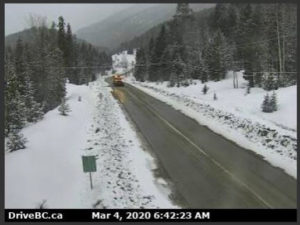 Visit DriveBC | www.drivebc.ca
Visit DriveBC | www.drivebc.ca
- For current road conditions
- For weather forecasts
- For real-time conditions via webcams
Fall and winter weather can be unpredictable and when we tend to experience all types of driving conditions; snow, heavy rain, fog, and icy conditions.
Give your vehicle a winter check-up and equip your family with a winter survival kit so you’re not caught off guard when weather conditions deteriorate.
We encourage drivers to choose the best winter tires possible when driving in snow and ice, and to ensure tires are in good condition, with a minimum tread depth of 3.5 mm.
Carry an emergency survival kit with non-perishable food, blankets and first aid supplies, windshield scraper and snow brush, extra windshield washer fluid, fuel line antifreeze, flares and matches or lighter, tire chains and gloves, shovel and traction mat, sand or kitty litter, flashlight and extra batteries, battery jumper cables, spare tire wheel wrench and jack, extra clothing and footwear and sandbags for extra weight.
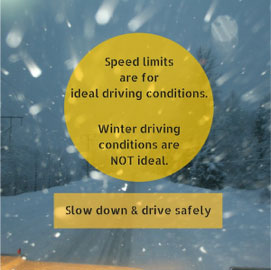 Driving during winter driving conditions
Driving during winter driving conditions
- Conditions change and so should your speed. Please SLOW DOWN and drive for the conditions.
- We encourage all motorists to drive to the conditions during the winter season, slow down, and increase the distance between yourself and the vehicle in front of you.
TranBC Link: How to drive around snow plows in British Columbia
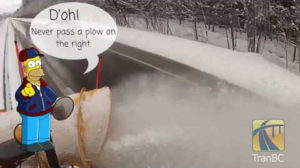 Snow Plow Safety Do’s and Don’ts
Snow Plow Safety Do’s and Don’ts
Do……Turn on your head and taillights during heavy snow or rain, even during the day.
Do……Use winter-rated snow tires with the mountain-snowflake symbol.
Do……Watch for the flashing amber lights. It can be difficult to see snow removal equipment.
Do… …Give snow plows plenty of space – about 10 car lengths. Salt and winter abrasives, as well as rocks and other debris in the snow, can fly – hitting nearby vehicles and decreasing visibility.
Do……Remember the road surface ahead of the plow hasn’t been plowed yet therefore please slow down and be patient. The operator will eventually pull over when it is safe to do so to allow motorists to pass, so take your time, wait and be safe.
Do……Pull as far over to the right as is safe when you see a snow plow approaching from the opposite direction along an undivided highway. That way, you will be clear of any salt or winter abrasives.
Do……Give the snow plow operator a wave when they pull over to let you pass. They’re doing the job for you!
Snow Plow Safety Do’s and Don’ts
Don’t……Assume the snow plow operator can see you, especially if you’re driving too close and visibility is poor (which it often is in snowstorms). Your best defense is to keep your distance.
Don’t…
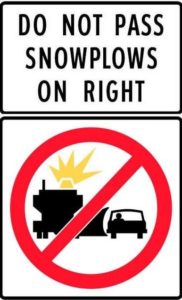 …Pass snow plows. It’s not safe. When drivers attempt to pass a plow truck, they put themselves, their passengers, the snow plow operator and other motorists at risk. The plow could be equipped with a wing blade on its left or right side, which can be obstructed by the snow it’s throwing. The plow also may be the first of a series of two to four more plows, staggered diagonally across the road to clear all lanes simultaneously. This practice is called Echelon Plowing and would require the unwise driver to make multiple unsafe passes.
…Pass snow plows. It’s not safe. When drivers attempt to pass a plow truck, they put themselves, their passengers, the snow plow operator and other motorists at risk. The plow could be equipped with a wing blade on its left or right side, which can be obstructed by the snow it’s throwing. The plow also may be the first of a series of two to four more plows, staggered diagonally across the road to clear all lanes simultaneously. This practice is called Echelon Plowing and would require the unwise driver to make multiple unsafe passes.
Don’t……Tailgate. Tailgating any vehicle puts you at risk of a collision; tailgating a piece of heavy equipment armed with plows only ups the consequences.
Drivers may not be aware…Snow plows must travel slower than regular traffic when pushing snow and spreading salt and winter abrasives.
Snow plows stop at railway crossings to ensure it is safe to cross and that the plow blade will clear the track.
Shift into Winter and TranBC Winter Driving Online Resources
Mainroad is a Winter Driving Safety Alliance partner. We actively promote Shift into Winter, a public awareness campaign designed to inform B.C. drivers about the importance of safe winter driving. We encourage everyone to visit www.shiftintowinter.ca for resources and tips on how to stay safe on the road this winter.
Municipal boundary snow removal operations
City of Cranbrook
City of Kimberley
- Snow Removal Information and FAQ’s
- Roads, Sidewalks and Pathways
- Snow and Ice Management Plan
- Map of Snow Removal Areas – Walks and Trails
City of Fernie
District of Elkford
District of Sparwood

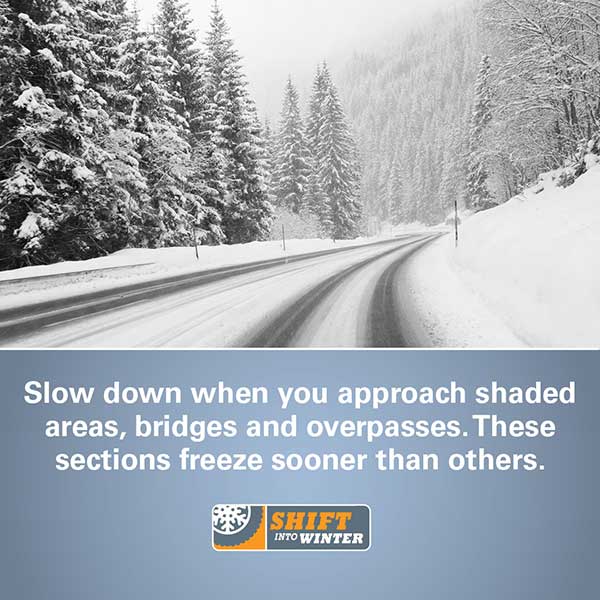
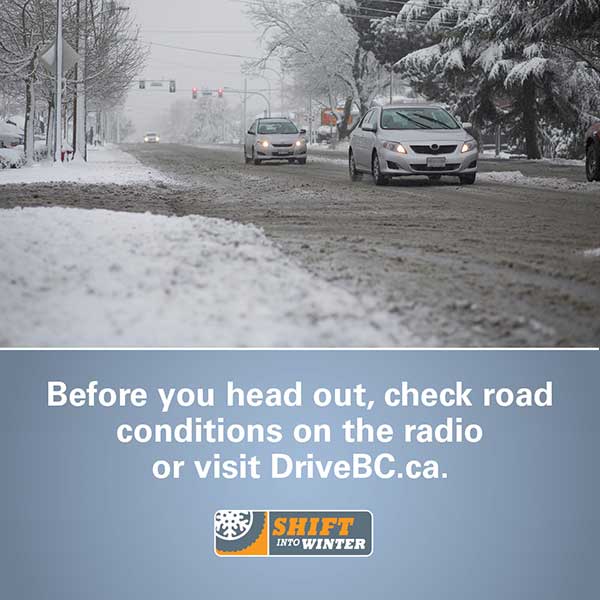
Additional information about B.C. Highway and Bridge Maintenance
Commercial Vehicle – Tire and Chain Requirements
Designated Winter Tire & Chain-up Routes
Enforcement of Winter Tires & Chains Requirement
Excessive Speed and Careless Driving
Motorcycle – Tire and Chain Requirements
Passenger Vehicle – Tire and Chain Requirements
Recreational Vehicle & Trailer – Tire and Chain Requirements
Location & Contact
- eastkootenay@mainroad.ca
- GM: Teagan Burton
- 258 Industrial Road F. Cranbrook, BC V1C 6N8

